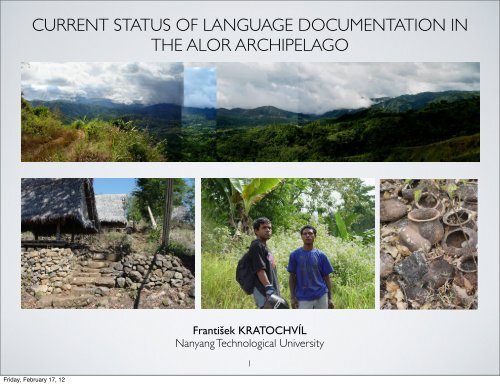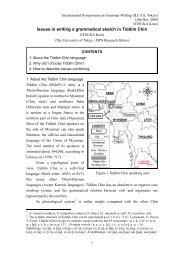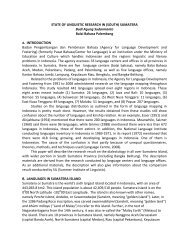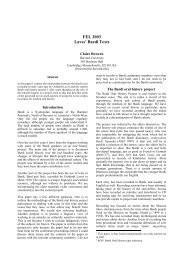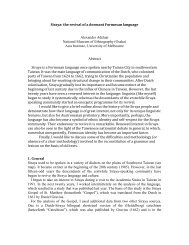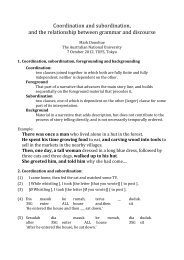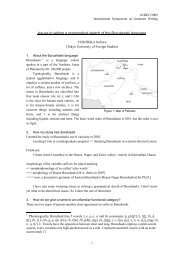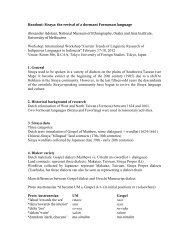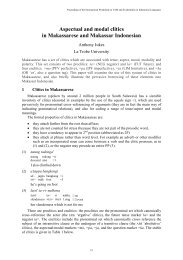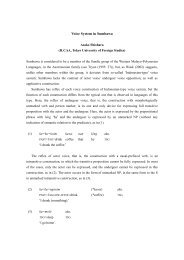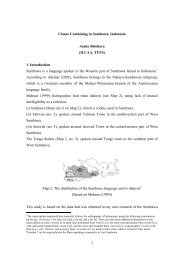Handout
Handout
Handout
Create successful ePaper yourself
Turn your PDF publications into a flip-book with our unique Google optimized e-Paper software.
CURRENT STATUS OF LANGUAGE DOCUMENTATION IN<br />
THE ALOR ARCHIPELAGO<br />
Friday, February 17, 12<br />
František KRATOCHVÍL<br />
Nanyang Technological University<br />
1
OUTLINE OF THE PAPER<br />
Introduction<br />
Early sources (1500-1950)<br />
• Pigafetta (1512)<br />
• Dutch administrators and travellers (Van Galen)<br />
• Cora Du Bois and M. M. Nicolspeyer (1930’s)<br />
1970’s<br />
• Stokhof and Steinhauer<br />
2000+’s<br />
• Mark Donohue (1997, 1999), Doug Marmion (fieldwork on Kui), Asako Shiohara (Kui)<br />
• Haan 2001 (U of Sydney)<br />
• Linguistic Variation in Eastern Indonesia project<br />
• Gary Holton<br />
• EuroBabel project<br />
Friday, February 17, 12<br />
2
GEOGRAPHIC LOCATION<br />
3<br />
Friday, February 17, 12
LINGUISTIC SITUATION (NOT SUPPORTED IN HOLTON ET AL. 2012)<br />
Friday, February 17, 12<br />
4
LINGUISTIC SITUATION<br />
5<br />
Friday, February 17, 12
Historical characteristics of AP group<br />
LINGUISTIC SITUATION<br />
1. Papuan outlier (some 1000 km from the New Guinea mainland)<br />
2. tentatively linked with Trans New Guinea (TNG) family - western<br />
Bomberai peninsula languages (Ross 2005) based on pronominal<br />
evidence<br />
>>> not supported in Holton et al 2012<br />
3. small languages (max. 20,000 speakers, some < 1,000)<br />
4. surrounded by Austronesian languages<br />
5. long history of genetic admixture (Mona et al. 2009)<br />
6. possibly long-lasting language contact and linguistic convergence<br />
(Holton et al. to appear)<br />
Friday, February 17, 12<br />
Frantiöek Kratochvíl et al. Pronominal systems in AP languages 8/77<br />
6
Diachronic development<br />
Discussion and Conclusion<br />
References<br />
Historical profile<br />
Typological profile<br />
LINGUISTIC CHARACTERISTICS<br />
Grammatical characteristics of the AP group<br />
1. head-final and head-marking<br />
2. great variation in alignment types: ranging from nom-acc (Haan<br />
2001; Klamer 2010) to fluid semantic alignment (Klamer 2008;<br />
Donohue and Wichmann 2008; Kratochvíl to appear; Schapper<br />
2011b)<br />
3. lexical class-based case-patterns in Western Pantar (Holton 2010)<br />
4. no nominal case, number, gender<br />
5. clause chaining (de Vries 2006)<br />
Friday, February 17, 12<br />
7<br />
Frantiöek Kratochvíl et al. Pronominal systems in AP languages 10/77
EARLY SOURCES (1500-1950)<br />
8<br />
Friday, February 17, 12
Donohue, Mark. 1996. Inverse in Tanglapui. Language and Linguistics in Melanesia<br />
27:101‒18.<br />
Donohue, Mark. 2008. Bound pronominals in the West Papuan languages. Morphology and<br />
language history: In honor of Harold Koch, ed. by Claire Bowern, Bethwyn Evans, and Luisa<br />
Miceli, 43‒58. Amsterdam: John Benjamins.<br />
Du Bois, Cora Alice. 1944. The people of Alor; a socio-psychological study of an East Indian<br />
Island. Minneapolis and St. Paul: The University of Minnesota.<br />
Fedden, Sebastian & Dunstan Brown. 2010. Pronominal marking in the Alor-Pantar<br />
languages. A paper read at the Linguistic Association of Great Britain Annual Meeting 2010,<br />
Leeds, September 1-4.<br />
Fedden, Sebastian, Dunstan Brown, Greville G. Corbett, Gary Holton, Marian Klamer, Laura<br />
C. Robinson & Antoinette Schapper. 2011. Conditions on prominal marking in the Alor-<br />
Pantar languages. Paper read at the annual meeting of the EuroBabel Project: Alor-Pantar<br />
Languages: Origins and Theorectical impact, 26 January 2011, Leiden University, the<br />
Netherlands.<br />
Haan, Johnson. 2001. The grammar of Adang, a Papuan language spoken on the island of<br />
Alor, East Nusa Tenggara, Indonesia. PhD thesis, University of Sydney.<br />
Hägerdal, Hans. 2010. Van Galen’s memorandum on the Alor Islands in 1946. An annotated<br />
translation with an introduction. Part 1. HumaNetten 25:14-44.<br />
Hägerdal, Hans. 2011. Van Galen’s memorandum on the Alor Islands in 1946. An annotated<br />
translation with an introduction. Part 2. HumaNetten 27:53-96.<br />
Holton, Gary. 2004. Report on recent linguistic fieldwork on Pantar Island, Eastern Indonesia.<br />
Report to the National Endowment for Humanities. Washington, DC.<br />
Holton, Gary. 2005. Grammatical relations in Western Pantar. Paper presented at the Annual<br />
meeting of the Linguistics Society of America, Oakland, California.<br />
Holton, Gary. 2007. Pronouns and pronominal prefixes in Alor-Pantar. Paper presented at the<br />
Workshop on Papuan languages in Manokwari, West Papua, Indonesia, August 2007.<br />
Holton, Gary. 2008. The rise and fall of semantic alignment in North Halmahera, Indonesia.<br />
In The typology of semantic alignment, ed. by Mark Donohue and Søren Wichmann, 252‒76.<br />
Oxford: Oxford University Press.<br />
Holton, Gary. 2010. Person-marking, verb classes, and the notion of grammatical alignment<br />
in Western Pantar (Lamma). In Typological and areal analyses: Contributions from East<br />
Nusantara, ed. by Michael Ewing and Marian Klamer, 101‒21. Canberra: Pacific Linguistics.<br />
MEMORIES VAN OVERGAVE (1850-1950)<br />
moko’s - local currency traditional art late colonialization<br />
2<br />
9<br />
Friday, February 17, 12
1970-1980<br />
10<br />
Friday, February 17, 12
1970-1980<br />
Holle Lists<br />
Stokhof, W. A. L. 1975. Preliminary notes on the Alor and Pantar languages (East Indonesia). Canberra: Dept.<br />
of Linguistics, Research School of Pacific Studies, Australian National University.<br />
Blagar<br />
Steinhauer, Hein. 1991. Demonstratives in the Blagar language of Dolap (Pura, Alor, Indonesia). In Papers in<br />
Papuan linguistics, ed. by Tom Dutton, 177‒221. Canberra: Pacific Linguistics.<br />
Steinhauer, Hein. 1995. Two varieties of the Blagar language (Alor, Indonesia). In Tales from a concave<br />
world: Liber amicorum Bert Voorhoeve, ed. by Connie Baak, Mary Bakker, and Dick van der Meij, 269‒<br />
96. Leiden: Projects Division Department of Languages and Cultures of South-East Asia and Oceania.<br />
Kamang (Woisika)<br />
Stokhof, W. A. L. 1977. Woisika I: An ethnographic introduction. Canberra: Pacific Linguistics.<br />
Stokhof, W. A. L. 1979. Woisika II: Phonemics. Canberra: Pacific Linguistics.<br />
Stokhof, W. A. L. 1982. Woisika riddles. Canberra: Pacific Linguistics.<br />
Abui<br />
Stokhof, W. A. L. 1984. Annotations to a text in the Abui language (Alor). Bijdragen tot de Taal-, Land- en<br />
Volkenkunde 140:106‒62.<br />
Friday, February 17, 12<br />
11
2000+<br />
12<br />
Friday, February 17, 12
LANGUAGE DOCUMENTATION RESULTS IN 2000+ PERIOD<br />
Grammars:<br />
Abui, Adang, Alorese, Klon, Teiwa<br />
Dictionaries:<br />
Abui, Kamang, Teiwa, Western Pantar<br />
Story books:<br />
Abui<br />
Bible translations:<br />
Blagar (AuSIL), Sawila, Kula, Wersing (ongoing, in different stages)<br />
Friday, February 17, 12<br />
13
3. THE DATA. There are over twenty Papuan languages spoken across Alor, Pantar,<br />
and the islands in the intervening straits. 9 In this paper we present data from twelve<br />
languages (listed in table 1), with representatives from across the entire geographical<br />
DATA COLLECTED IN 2000+ PERIOD<br />
TABLE 1. SOURCES CONSULTED FOR THIS PAPER<br />
LANGUAGE ABBR. STOKHOF<br />
ISO<br />
CODE<br />
RESEARCHER YEAR(S) NO.<br />
ITEMS<br />
SOURCE(S)<br />
(1975)<br />
Teiwa TWA Tewa twe Klamer 20037, 1350 Klamer 2010a, forthcoming:a<br />
2010<br />
Robinson 2010 ~400 fieldnotes<br />
Nedebang NDB Nedebang nec Robinson 2010 ~400 fieldnotes<br />
Kaera KER — — Klamer 20067 890 fieldnotes, Klamer 2010b<br />
Robinson 2010 ~400 fieldnotes<br />
Western<br />
Pantar †<br />
WP Lamma lev Holton 20068 2500 Holton and Lamma Koly<br />
2008<br />
Blagar ‡ BLG Blagar beu Robinson 2010 ~400 fieldnotes<br />
Adang ADN Adang adn Robinson 2010 ~400 fieldnotes<br />
Baird 2003 419 fieldnotes<br />
Klon KLN Kelon kyo Baird 20037 ~1600 Baird 2008, fieldnotes<br />
Robinson 2011 ~400 fieldnotes<br />
Kui — Kui kvd Holton 2010 432 fieldnotes<br />
Abui ABU Abui abz Schapper 2010 ~400 fieldnotes<br />
Kratochvíl 20039 1725 Kratochvíl 2007, Kratochvíl<br />
and Delpada 2008<br />
Kamang KMN Woisika woi Schapper 2010 ~1800 fieldnotes<br />
Sawila SWL Tanglapui tpg Kratochvíl 20079 ~1800 fieldnotes<br />
Wersing WRS Kolana kvw Holton 2010 432 fieldnotes<br />
† Western Pantar is a cover label first used by Holton (2004) for three mutually intelligible<br />
dialects: Mauta, Tubbe, and Lamma Holton (labels et al. are 2012 based on clan names). The name “Lamma”<br />
is used in Stokhof (1975) for all varieties of the language.<br />
‡ Blagar exhibits significant dialect variation with respect to the consonants. Unless otherwise<br />
noted, the data cited in this paper are from the Nuhawala “Nule” dialect spoken on Pantar.<br />
14<br />
Friday, February 17, 12
114 OCEANIC LINGUISTICS, VOL. 51, NO. 1<br />
FIGURE 2. SUBGROUPING OF ALOR-PANTAR BASED ON SHARED<br />
PHONOLOGICAL INNOVATIONS<br />
COMPARATIVE METHOD RESULTS (HOLTON ET AL. 2012)<br />
PAP<br />
Alor<br />
(*k,*q merge)<br />
West Alor<br />
(*s>h)<br />
Straits<br />
(*k>, *g>)<br />
East Alor<br />
(*b>p, *s>t)<br />
TWA NDB KER WP BLG ADN KLN Kui ABU KMN SWL WRS<br />
The tree based on shared phonological Holton innovations et al. 2012 differs in several ways from previous<br />
classifications based on lexicostatistics. In particular, while the eastern languages<br />
SWL and WRS form a subgroup, they do not 15 constitute primary branches from PAP, as<br />
has been suggested in several previous classifications (cf. Wurm 1982, Lewis 2009).<br />
Friday, February 17, 12
defining a group we label Straits. The latter change is also shared with KLN, providing<br />
weak support for an intermediate grouping that we label West Alor. The remaining changes<br />
cross-cut these and do not provide additional subgrouping information. See figure 2.<br />
COMPARATIVE METHOD RESULTS (HOLTON ET AL. 2012)<br />
TABLE 45. SOUND CHANGES FOUND IN AT LEAST TWO LANGUAGES<br />
CHANGE<br />
LANGUAGES<br />
*b > f TWA, NDB, ABU (in TWA and NDB only noninitially)<br />
*b > p KMN, SWL, WRS<br />
*d > r ABU, Kui (in Kui only finally)<br />
*g > BLG, ADN<br />
*k > / _# BLG, ADN<br />
*q > k WP, BLG, ADN, KLN, Kui, ABU, KMN, SWL, WRS (ADN < k < *q)<br />
*s > h BLG, ADN, KLN<br />
*s > t ABU, SWL, WRS<br />
*h > everywhere but TWA and WP<br />
*m > / _# WP, BLG, ADN<br />
*n > / _# NDB, KER, WP, BLG, ADN, ABU, KMN SWL, WRS<br />
*l > i / _# TWA, KER, ADN, KMN<br />
*l > / _# NDB, WP, ABU<br />
*r > l / V_V NDB, WP, ADN, KMN<br />
*r > / _# TWA, KER, WP<br />
*r > i / _# BLG, Kui, ABU<br />
Holton et al. 2012<br />
Friday, February 17, 12<br />
16
RECONSTRUCTED PROTO-<br />
ALOR-PANTAR VOCABULARY<br />
Holton et al. 2012<br />
*-ain(i,u) ‘name’ *jari ‘laugh’ *pVr ‘scorpion’<br />
*aman ‘thatch’ *jasi ‘bad’ *qaba(k) ‘spear’<br />
*aqana ‘black’ *jibC ‘star’ *qar- ‘tens’<br />
*-ar ‘vagina’ *jira ‘water’ *qin ‘mosquito’<br />
*araqu ‘two’ *jira(n) ‘fly’ (v.) *siba ‘new’<br />
*asi ‘bite’ *jiwesin ‘five’ *talam ‘six’<br />
*bagai ‘crocodile’ *kusin ‘fingernail’ *tam ‘saltwater’<br />
*balin ‘axe’ *kVt ‘flea’ *tama ‘fat’<br />
*baj ‘pig’ *-leb(ur) ‘tongue’ *-tan ‘hand/arm’<br />
*bis ‘mat’ *luk(V) ‘crouch’ *tapai ‘pierce’<br />
*bob ‘wave’ *lVsi ‘monitor lizard’ *tas ‘stand’<br />
*bui ‘betel nut’ *madel ‘bat’ (n.) *tei ‘tree’<br />
*bukan ‘guard’ *mai ‘come’ *temVk ‘bedbug’<br />
*bunaq ‘smoke’ *mait ‘betel vine’ *ten ‘ripe’<br />
*dar(a) ‘sing’ *mari ‘bamboo’ *tia ‘recline’<br />
*dul(a) ‘slippery’ *mi ‘(be) in/on’ *tiara ‘expel’<br />
*dumV ‘thick’ *mid ‘climb’ *-tiari(n) ‘close’ (v.)<br />
*dur ‘rat’ *-mim ‘nose’ *-tok ‘stomach’<br />
*dVl ‘bird’ *minV ‘die’ *tukV ‘short’<br />
*-ena ‘give (to s.o.)’ *mis ‘sit’ *u:b ‘sugarcane’<br />
*ga- 3SG *mogol ‘banana’ *-uaqal ‘child’<br />
*ge- 3GEN *mudi ‘body hair’ *-uar(i) ‘ear’<br />
*gi- 3PL *mudin ‘plant’ (v.) *-uas ‘teeth’<br />
*ha- 2SG *-muk ‘horn’ *uku ‘knee’<br />
*hab(i) ‘fish’ *na- 1SG *Vde ‘burn’<br />
*haban ‘village’ *nai ‘eat/drink’ *wad(i) ‘sun’<br />
*had(a) ‘fire’ *naN(a) ‘sibling’ *wai ‘blood’<br />
*hami ‘breast’ *nuk ‘one’ *war ‘stone’<br />
*has ‘excrement’ *-od ‘throw’ *wat(a) ‘coconut’<br />
*hasak ‘empty’ *-or(a) ‘tail’ *weli ‘bathe’<br />
*hawar ‘lime’ *p(i,u)nV ‘hold’ *wur ‘moon’<br />
*hipar ‘dream’ *pi- 1pl.incl<br />
*is(i) ‘fruit’ 17 *purVN ‘spit’<br />
Friday, February 17, 12
TABLE 47. PAP COMPARED WITH PTNG (Pawley n.d.)<br />
PROTO-ALOR-PANTAR<br />
COMPARED WITH PTNG<br />
Holton et al. 2012<br />
PAP<br />
PTNG<br />
*balin *tu ‘axe’<br />
*dVl *n[e]i, *jaka, *nVma ‘bird’<br />
*wai *ke(nj,s)a ‘blood’<br />
*hami *amu ‘breast’<br />
*mai *me- ‘come’<br />
*minV *kumV- ‘die’<br />
*-uar(i) *ka(nz,t)(i,e)[C], *tVmV[d] ‘ear’<br />
*nai *na- ‘eat/drink’<br />
*has *ata ‘excrement’<br />
*kusin *mbutuC ‘fingernail’<br />
*had(a) *kend(o,u)p, *inda ‘fire’<br />
*jira(n) *pululu- ‘fly’ (v.)<br />
*-ena *mV ‘give (to s.o.)’<br />
*-tan *sa(ªg,k)al ‘hand/arm’<br />
*uku *(g,k)atuk ‘knee’<br />
*jari *ªgiti ‘laugh’<br />
*wur *takVn[V], *kal(a,i)m ‘moon’<br />
*qin *kasin ‘mosquito’<br />
*-ain(i,u) *imbi, *wani ‘name’<br />
*siba *kVtak ‘new’<br />
*-mim *mundu ‘nose’<br />
*tukV *[ka]tumba[C], *tukumba[C], *kumb(a,u) ‘short’<br />
*mis *mna- ‘sit’<br />
*bunaq *kambu(s,t)(a,u), *(kambu-)la(ªg,k)a ‘smoke’<br />
*tas *t(a,e,i)k[V]- ‘stand’<br />
*war *ka(mb,m)u[CV],*[na]muna ‘stone’<br />
*wad(i) *kamali, *ketane ‘sun’<br />
*-or(a) *a(mb,m)u ‘tail’<br />
*-uas *maªgat[a], *(s,t)i(s,t)i ‘teeth’<br />
*-leb(ur) *mbilaª, *me(l,n)e ‘tongue’<br />
*tei *inda ‘tree’<br />
*araqu *ta(l,t)(a,e) ‘two’<br />
*jira *ok[V], *nVk, nVL ‘water’<br />
*ha- 18*ªga[k] 2SG<br />
Friday, February 17, 12
Table 1 presents an overview with the reconstructions to proto-Alor-Pantar (pAP). The<br />
PAP numerals ‘one’ to ‘five’ have been retained in most of its decedents. Only Sawila has<br />
innovated numerals in this range (non-cognate forms are bracketed).<br />
ALOR-PANTAR NUMERALS<br />
Table 1: AP numerals ‘one’ to ‘five’<br />
1 2 3 4 5<br />
pAP *nuku *araqu *(a)tiga *{/b}uta *yiwesing<br />
Pantar Western Pantar anuku alaku atiga atu yasing<br />
Deing nuk raq atig ut asan<br />
Sar nuk raq tig ut yawan<br />
Teiwa nuk raq yerig ut yusan<br />
Kaera nuko raxo tug ut isin<br />
Straits Blagar-Bama nuku akur tuge uut ising<br />
Blagar-Dolap nu aru tue uta ising<br />
Reta anu alo atoga w/uta avehang<br />
W Alor Kabola nu olo towo ut iweseng<br />
Adang nu alo tuo ut ifihing<br />
Hamap nu alo tof ut ivehing<br />
Klon nuk orok tong ut eweh<br />
Kui nuku oruku siwa usa yesan<br />
C&E Alor Abui nuku ayoku sua buti yeting<br />
Kamang nok ok su biat iwesing<br />
Sawila (sundana) yaku tuo (araasiiku) yooting<br />
The correspondences in the numerals are for the most part regular, but there are a few<br />
Klamer et al. 2011<br />
developments in individual languages that are note-worthy:<br />
A non-etymological initial /a/ is present on Western Pantar ‘one’ and ‘four’ and Reta<br />
‘one’. This development is apparently due to 19analogy with the numerals ‘two’ and possibly<br />
‘three’. Such analogical adjustments in numeral forms are cross-linguistically very<br />
Friday, February 17, 12
All AP languages have monomorphemic forms for ‘1’ to ‘5’, almost all of which are<br />
cognate. Most AP languages also have a monomorphemic ‘6’. In the majority of languages,<br />
the numerals ‘7’-‘9’ are constructed ALOR-PANTAR with a quinary NUMERALS<br />
base, as shown in Table 6. This pattern<br />
is found in the geographically discontinous languages of Pantar, Central Alor, and East<br />
Alor. We assume that these systems represent reflexes of the proto-AP numeral system.<br />
The Straits and West Alor languages independently developed an additive base-10<br />
system for the numerals 7-9. Next, they replaced the base of ‘7’ with an Austronesian ‘7’,<br />
incorporating it as a base in the subtractive system.<br />
Table 6. Summary of patterns of AP numerals ‘5’-‘9’, West to East<br />
‘5’ ‘6’ ‘7’ ‘8’ ‘9’<br />
Western Pantar 5 6 7+2 7+3 ‘1 less’<br />
Central East Pantar 5 6 5+2 opaque 5+3 opaque 5+4 opaque<br />
Straits-West Alor 5 6 7[-]3 [10]-2 [10]-1<br />
Kui 5 6 5+2 [10]*4 5+4<br />
Central Alor 5 6 5+2 transparent 5+3 transparent 5+4 transparent<br />
East Alor 5 5+1 5+2 transparent 5+3 transparent 5+4 transparent<br />
11<br />
Klamer et al. 2011<br />
Friday, February 17, 12<br />
20
Abui shows the greatest amount of irregularity between the forms of its basic, cardinal<br />
numerals and its reduplicated, distributive numerals. We analyse the modern differences as<br />
the result of fossilised changes which historically applied to numerals on reduplication.<br />
These are overviewed in (1) with changes applying from left to right: (i) the basic cardinal<br />
numeral was first reduced by its final V(C), where the final syllable was of the shape<br />
CV(C); (ii) the final segment of its reduced root form in some cases then underwent a shift<br />
(a>i, k>t and m>n) 10 ; (iii) this root was then reduplicated and suffixed with –da, which<br />
subsequently fused to the root and changed shaped (da ~ na ~ ra).<br />
ABUI REDUPLICATED NUMERALS ‘N-times’ AND ‘in groups of N’<br />
The historical changes applying to Abui reduplicative numerals<br />
(16) Cardinal Root reduction Final segment shift Redup +da<br />
nuku > *nuk -- nuk~ nukda<br />
ayoku > *ayok -- ayok~ ayokda<br />
sua > -- *sui sui~ suida<br />
buti > *but *buk buk~ bukna<br />
yeting > *yet *yek yek~ yekna<br />
talaama > *talam *talan talan~ talanra<br />
Abui has one further irregularity amongst its distributive numerals: aisaha ‘100’ from<br />
the cardinal aisa ‘100’. Aisaha is itself never reduplicated, but it is required in the<br />
formation of any distributive numeral including the base ‘100’. It possibly represents an<br />
earlier form of the numeral (cf. Km asaka ‘100’).<br />
In Kamang, there is also no regular pattern for the reduplication of numerals. In the<br />
numerals ‘one’ to ‘four’ and ‘six’ a morpheme Klamer et al. with 2011 the shape (C)V(:) is reduplicated, while<br />
in the numeral ‘five’ and complex numerals built on it (i.e., ‘seven’ to ‘nine’), the<br />
reduplicant has the shape CVCV.<br />
21<br />
Friday, February 17, 12
DEMONSTRATIVES<br />
Demonstrative extended to various grammatical functions are found in at least Adang,<br />
Abui and Bunaq and used with similar functions in Alor Malay (replication)<br />
Extended also to cover various pragmatic functions<br />
Kratochvíl. 2011, Schapper and San Roque 2011<br />
Friday, February 17, 12<br />
22
DEMONSTRATIVES<br />
viewpoint elevation<br />
distance speaker addressee low high<br />
proximal do to<br />
prx prx.ad<br />
medial o, lo yo ò ó<br />
md md.ad md.l md.h<br />
distal oro wò wó<br />
dst dst.l dst.h<br />
Table 1: Abui demonstratives<br />
indicating the discourse location of the referent is probably secondary (marked<br />
Kratochvíl. 2011, Schapper and San Roque 2011<br />
with subscript a ). Abui np template is given in (4):<br />
(4) [dem s / nmc s (poss-)n n/adj/v/quant/ 23 ba + nmc dem a ] NP<br />
Friday, February 17, 12
PROXIMAL DEMONSTRATIVES ENCODING EVENT TIME<br />
0 František Kratochvíl<br />
(29) a. di de-melang da-wai yaar do<br />
3A 3I.AL-village 3I.PAT-turn go.CPL PRX<br />
‘he just went back to his village’<br />
b. di de-melang da-wai yaar to<br />
3A 3I.AL-village 3I.PAT-turn go.CPL PRX.AD<br />
‘you know that he just went back to his village’<br />
The medial forms in (30) indicate a longer distance between the coding<br />
temporal location of an event. Again, addressee-based forms are used to<br />
addressee’s knowledge of the event. The completive stem of the verb yaar<br />
Kratochvíl. 2011<br />
with perfective suffix -i (PFV) to indicate that the event of going back is fi<br />
Friday, February 17, 12<br />
24<br />
(30) a. di de-melang da-wai yaar-i o
3A 3I.AL-village 3I.PAT-turn go.CPL PRX.AD<br />
‘you know that he just went back to his village’<br />
MEDIAL DEMONSTRATIVES ENCODING EVENT TIME<br />
The medial forms in (30) indicate a longer distance between the coding time and the<br />
temporal location of an event. Again, addressee-based forms are used to appeal to the<br />
addressee’s knowledge of the event. The completive stem of the verb yaar ‘go’ combines<br />
with perfective suffix -i (PFV) to indicate that the event of going back is finished:<br />
(30) a. di de-melang da-wai yaar-i o<br />
3A 3I.AL-village 3I.PAT-turn go.CPL-PFV MD<br />
‘he went back to his village some time ago’<br />
b. di de-melang da-wai yaar-i yo<br />
3A 3I.AL-village 3I.PAT-turn go.CPL-PFV MD.AD<br />
‘you should know that he went back to his village some time ago’<br />
The distal forms are used when the speaker is uncertain about the exact temporal<br />
location of an event that occurred in the past. 8 The temporal use of demonstratives<br />
overlaps here with their evidential and mood use discussed in Section 3.3.2. This<br />
is illustrated in (31b) where the addressee-based form hu (SPC.AD) marks irrealis.<br />
Kratochvíl. 2011<br />
In natural speech, the ambiguity is resolved by the context; the elicited examples<br />
illustrating the paradigm are ambiguous: 25<br />
Friday, February 17, 12
e distal forms are used when the speaker is uncertain about the exact tempor<br />
cation of an event that occurred in the past. 8 The temporal use of demonstrativ<br />
erlaps here DISTAL with DEMONSTRATIVES their evidential and mood ENCODING use discussed EVENT in Section TIME 3.3.2. Th<br />
illustrated in (31b) where the addressee-based form hu (SPC.AD) marks irreali<br />
natural speech, the ambiguity is resolved by the context; the elicited exampl<br />
lustrating the paradigm are ambiguous:<br />
(31) a. di de-melang da-wai yaar nu<br />
3A 3I.AL-village 3I.PAT-turn go.CPL SPC<br />
‘he went back to his village (a certain time, long time ago)’<br />
b. di de-melang da-wai yaar hu<br />
3A 3I.AL-village 3I.PAT-turn go.CPL SPC.AD<br />
‘it would be better if he had gone back to his village’<br />
s (31) shows, Abui demonstratives do not only mark past tense. They indicate th<br />
mporal ‘distance’ from the coding time. In (32), the medial demonstrative o (MD<br />
fers to a nearby future event. Another example, illustrating the tense marking use<br />
(MD) is given in (56).<br />
Kratochvíl. 2011<br />
(32) na o-pa=ng marang o<br />
26<br />
1S 2S.REC-TOUCH.CNT=LOOK come.up MD<br />
Friday, February 17, 12
‘I couldn’t eat up (swallow) anything’<br />
In (41), MEDIAL A is not DEMONSTRATIVES aware of the poor ENCODING health of B’s mother. EVIDENCE B considers<br />
obvious as he uses to (PRX.AD) to indicate that A has sufficient evide<br />
proposition.<br />
(41) A: mangmat,# ma e-ya yo<br />
foster.child be.PRX 2S.AL-mother MD.AD<br />
‘child, what about your mother’<br />
B: ni-ya ha-rik to!<br />
1PE.AL-mother 3II.PAT-hurt PRX.AD<br />
‘my mother is sick (as you could see)’<br />
The medial addressee-based demonstrative yo (MD.AD) is used when<br />
based on earlier evidence available to the addressee; in (42), the spe<br />
the addressee knew about the funeral:<br />
Kratochvíl. 2011<br />
(42) pi yaar-i ni-ya 27 do nabuk yo<br />
Friday, February 17, 12
‘hold it (a bow) so that it would become tight’<br />
There are LAYERING a few cases, IN showing SENTENCE that evidentiality FINAL POSITION and assertion (ABUI) are encode<br />
dently in distinct syntactic positions. In the surface structure it appears a<br />
demonstrative is doubled, as in (48). In fact each of the demonstrative<br />
different grammatical category. The addressee-based to encodes the e<br />
while do indicates the assertion.<br />
(48) na-táng do,# di namur to do!<br />
1S.INAL-hand PRX 3A wound.CPL PRX.AD e<br />
PRX as<br />
‘my hand really got hurt just a while ago (as you know)!’<br />
The demonstrative in the slot closer to the VP encodes the source of inform<br />
sentence-final demonstrative marks assertion, proposing to the addres<br />
the context. In (49), the first proximal do encodes the source as first-han<br />
the second do marks assertion:<br />
Kratochvíl. 2011<br />
(49) ma iti,# it de-i do do<br />
28<br />
be.PRX that lie.on 3I.LOC-put PRX e<br />
PRX as<br />
Friday, February 17, 12
‘you should calm down and sleep!’<br />
3.4 Overview<br />
ABUI PRONOMINAL DEMONSTRATIVES<br />
Table 4 summarises functions of Abui pronominal demonstratives. The table<br />
shows that each function is associated with a particular syntactic position.<br />
domain structure function<br />
np dem s (poss-) N n/adj/v/quant dem a dem s space<br />
dem a anaphora<br />
clause adem s u PRED dem t dem s space<br />
dem t temporal location<br />
sentence [. . . dem rt ] SC [. . . dem t ] MC dem e dem as dem rt relative temporal location<br />
dem t temporal location<br />
dem e evidentiality<br />
dem as assertion<br />
Table 4: Functions of Abui demonstratives in various syntactic domains<br />
We have seen, that addressee-based demonstratives allow Abui speakers to<br />
point out to addressees’ viewpoint and interact with their stance. The default<br />
speaker-based forms are used when speakers’ viewpoint and stance is presented.<br />
Kratochvíl. 2011<br />
Distal forms are use when speaker’s commitment is low and a generally valid<br />
stance (culturally appropriate behaviour, etc.) is pointed out.<br />
Friday, February 17, 12<br />
29
ABUI ADVERBIAL~VERBAL DEMONSTRATIVES<br />
by the Abui data is the basic distinction between reference and predication.<br />
While evidentiality is primarily a referential operation, epistemic modality is a<br />
predication about a proposition.<br />
Table 6 lists the functions of Abui adverbial demonstratives. English equivalents<br />
are given for the dynamic, deontic and epistemic modals.<br />
form space modal dyn modal deo modal epi<br />
ma proximal just want probably<br />
spontaneously<br />
ta proximal AD just AD want AD probably AD<br />
spontaneously AD<br />
la medial keep need apparently<br />
suddenly<br />
obviously<br />
jointly<br />
fa medial AD be forced AD need AD actually AD<br />
ya distal happen to might possibly<br />
somehow<br />
Table 6: Functions of Abui adverbial demonstratives<br />
Kratochvíl. 2011<br />
The structure of the modal categories in Abui is quite unique. As mentioned<br />
earlier, it has been reported in the literature, that di erent types of modality<br />
show congruent marking (cf.<br />
30<br />
Palmer 2001:7-8). However, I have not been<br />
Friday, February 17, 12
dst nu 864 hu 359<br />
ya 1630 (incl. seq)<br />
Table 7: Corpus frequencies of Abui demonstratives (July 19, 2011)<br />
ABUI DEMONSTRATIVES AND STANCE MARKING<br />
Abui demonstratives interact with other grammatical categories, such as<br />
vocatives, left-periphery and right-periphery discourse particles and evaluative<br />
predicates, as well as with case marking.<br />
stance type grammatical category grammatical device<br />
evaluation dem, right-periphery addressee-baseddem, variousverbs<br />
moral stance dem, case pronominaldem, 3i pronouns<br />
commitment dem dem epi ,proximalsentence-finaldem as<br />
interaction dem, vocatives addressee-baseddem, kinshipterms<br />
solidarity vocatives kinship terms, proper names<br />
subjectivity dem proximal pronominal and adverbial dem<br />
objectivity dem medial pronominal and adverbial dem<br />
distancing dem distal pronominal and adverbial dem<br />
disagreement dem, left-periphery addressee-baseddem, particlema<br />
Table 8: Stance marking strategies<br />
The future research will focus in more detail on the remaining discourse<br />
markers and clause linkers. I will also Kratochvíl. attempt 2011 to formulate definitions of Abui<br />
demonstratives in the NSM metalanguage.<br />
Friday, February<br />
Abbreviations<br />
17, 12<br />
31
Abui tripartite verbs: exploring the limits of compositionality 219<br />
(INNOVATED, ONOMATOPOEIA DRIVEN)<br />
Table 8. Complex verbs with a contrasting final generic verb k, l, ng, and i<br />
THROW LIE TOUCH<br />
a. t-u-k t-u-t- t-u-p-<br />
LIE-LEAVE-THROW LIE-LEAVE-LIE LIE-LEAVE-TOUCH<br />
‘stick out, measure’ ‘emerge, surface’ ‘stuck out’<br />
b. t-a-k t-a-p-<br />
LIE-AT-THROW<br />
Klamer and Kratochvíl 2010<br />
LIE-AT-TOUCH<br />
‘shoot, empty’<br />
‘shot (down)’<br />
c. k-a-k k-a-p-<br />
THROW-AT-THROW<br />
‘stab’<br />
d. l-u-k l-u-t-<br />
GIVE-LEAVE-THROW<br />
GIVE-LEAVE-LIE<br />
THROW-AT-TOUCH<br />
‘stabbed (in)’<br />
‘rub, wipe, bend’ ‘rubbed, bent’<br />
e. m-o-k m-o-p-<br />
IN-POINT-THROW<br />
‘put together’<br />
f. t-e-k t-e-t-<br />
LIE-MOVE-THROW<br />
LIE-MOVE-LIE<br />
‘slide’<br />
‘slid on’<br />
g. k-e-k k-e-t-<br />
THROW-MOVE-THROW<br />
‘prod’<br />
ANALOGICAL CHANGE IN ABUI<br />
THROW-MOVE-LIE<br />
‘prodded’<br />
IN-POINT-TOUCH<br />
‘(already) put together’<br />
motion state, horizontal state, contact<br />
Friday, February 17, 12<br />
to a wall that collapsed during an earthquake. The final generic verb t ‘lie’<br />
indicates the final horizontal position32of the wall has been reached. Tet is the<br />
final verb of the sentence and has to be inflected for aspect, in this case with
218 Marian Klamer & František Kratochvíl<br />
Table 7. Complex verbs with a contrasting final generic verb k, l, ng, and i<br />
THROW GIVE LOOK PUT<br />
a. d-a-k d-a-l d-a-i<br />
HOLD-AT-THROW HOLD-AT-GIVE HOLD-AT-PUT<br />
‘cover’ ‘handle, grab’ ‘cram(med)’<br />
b. l-e-k l-e-l l-e-i<br />
GIVE-MOVE-THROW GIVE-MOVE-GIVE GIVE-MOVE-PUT<br />
‘point to’ ‘threaten, almost do’ ‘miss (not hit)’<br />
c. t-u-k t-u-l t-u-ng<br />
LIE-LEAVE-THROW LIE-LEAVE-GIVE LIE-LEAVE-LOOK<br />
‘stick out, measure’ ‘stick into’ ‘perforate, pierce’<br />
d. l-u-k l-u-ng<br />
GIVE-LEAVE-THROW<br />
‘rub, wipe, bend’<br />
ONOMATOPOEIA AND RHYMING IN ABUI<br />
(KLAMER & KRATOCHVÍL 2010)<br />
GIVE-LEAVE-LOOK<br />
‘be long-termed’<br />
motion caused event oriented to location accomplished<br />
This system has probably developed quite recently, as the neighbouring languages don’t have<br />
anything similar. Possibly similar patterns can result in non-concatenating moprhology, as in<br />
Some more complex verbs with final generic verbs k ‘throw’, i ‘put’, l<br />
Semitic languages (Hebrew, Arabic).<br />
‘give’, and ng ‘look’ are given in Table 7. As was noted in Section 2, the<br />
derivational patterns shown by the 33 paradigms are not always regular, and<br />
combinations that are logically possible are not always attested. Note also that<br />
Friday, February 17, 12
a AT progressive no boundary<br />
e MOVE ingressive bounded at start<br />
o POINT punctual bounded at start and end<br />
ONOMATOPOEIA AND RHYMING IN ABUI<br />
(KLAMER & KRATOCHVÍL 2010)<br />
Table 11. Derivations with contrasting generic verbs in medial position<br />
a (AT) l-a-k k-a-k t-a-k<br />
progressive GIVE-AT-THROW THROW-AT-THROW LIE-AT-THROW<br />
‘mark, count’ ‘penetrate, stab’ ‘put down, shoot’<br />
o (POINT) l-o-k k-o-k t-o-k<br />
punctual GIVE-POINT-THROW THROW-POINT-THROW LIE-POINT-THROW<br />
‘prick’ ‘prod (once)’ ‘drop, pour’<br />
i (PUT) l-i-k k-i-k t-i-k<br />
terminative GIVE-PUT-THROW THROW-PUT-THROW LIE-PUT-THROW<br />
‘bend’ ‘sweep’ ‘loosen, untie’<br />
e (MOVE) l-e-k k-e-k t-e-k<br />
ingressive GIVE-MOVE-THROW THROW-MOVE-THROW LIE-MOVE-THROW<br />
‘point to / at’ ‘prod’ ‘slide’<br />
u (LEAVE) l-u-k k-u-k t-u-k<br />
perfect GIVE-LEAVE-THROW THROW-LEAVE-THROW LIE-LEAVE-THROW<br />
‘rub, bend’ ‘push out’ ‘stick’<br />
ble 11 is exmplified in (10)–(16). In (10), the verb t-a-k refers to shooting<br />
down of a pig. The root a ‘at’ in the complex verb t-a-k refers to the aktionsart<br />
of ‘lying’ and indicates that the event of ‘lying’ has no internal boundary.<br />
34<br />
Friday, February 17, 12
ONOMATOPOEIA AND RHYMING<br />
bang clang ram slam cram spam<br />
bash clash smash slash crash<br />
clap rap slap crap<br />
bat rat spat<br />
batter clatter smatter rattle spatter<br />
This pattern did not exist in Old English. The verb clatter is attested in the 13th century, and<br />
the full pattern emerges only in the 14th century.<br />
Friday, February 17, 12<br />
35
object (de Swart 2007). Because there is no nominal case in Abui and the notions<br />
of ‘subject’ and ‘object’ are problematic, I will use a more neutral term ‘differential<br />
realisation of arguments’ here. I will explore manifestations of this phenomenon<br />
in Abui in the following sections.<br />
PERSON MARKING ALTERNATIONS IN ABUI<br />
Friday, February 17, 12<br />
Table 3. Distribution of Abui pronominal prefixes<br />
verb pat rec loc goal ben<br />
a. fanga ha-fanga do-fanga he-fanga noo-fanga nee-fanga<br />
‘say’ ‘request him’ ‘ask for himself<br />
’<br />
‘say it’ ‘scold me’ ‘say for me’<br />
b. liya ha-liya do-liya he-liya noo-liya nee-liya<br />
‘fly’ ‘shoot it’ ‘fly on his own’ ‘fly on it’ ‘fly to me’ ‘fly for me’<br />
c. faaling *ha-faaling do-faaling he-faaling noo-faaling nee-faaling<br />
‘listen’<br />
‘listen for<br />
himself ’<br />
‘listen to it’ ‘listen to me’ ‘listen for me’<br />
d. wik ha-wik no-wik he-wik noo-wik nee-wik<br />
‘carry’<br />
‘carry him’<br />
(child)<br />
‘carry for<br />
myself ’<br />
‘carry it’ ‘let me carry’ ‘carry for me’<br />
e. rumai ha-rumai no-rumai he-rumai noo-rumai nee-rumai<br />
‘strong’ ‘strengthen it’ ‘I feel strong’ ‘it is strong’ ‘rely on me’ ‘strong for me’<br />
f. fahak *ha-fahak *ho-fahak he-fahak noo-fahak nee-fahak<br />
‘embrace’ ‘embrace it’ ‘hug me’ ‘hug for me’<br />
g. dik ha-dik no-dik he-dik noo-dik hee-dik<br />
Kratochvíl 2011<br />
‘stab’ ‘pierce it ‘I am stabbing’ ‘stab (at) it’ ‘poke him’ ‘stab for him’<br />
(through)’<br />
36<br />
h. tang ha-tang no-tang he-tang noo-tang hee-tang
Control [+ctrl] and affectedness [+aff] distinguish acting participants from<br />
affected ones in Abui. Affectedness and control represent the most significant difference<br />
between the two participants and each of them is further subdivided in<br />
subtypes. I have shown that control entails instigation [+inst] (Section 3.6) and is<br />
closely associated with volition [+vol] (Section 3.5). In Section 3.2 I have argued<br />
SEMANTIC FEATURES OF RELEVANCE FOR ABUI AGREEMENT<br />
Table 15. Semantic features of relevance for Abui argument realisation<br />
type feature abbreviation<br />
a. referential specificity [±spc]<br />
b. actor instigation [±inst]<br />
control<br />
volition<br />
[±ctrl]<br />
[±vol]<br />
c. undergoer affectedness (potential change) [±aff]<br />
individuation<br />
change (non-quantised)<br />
change of state (quantised)<br />
[±ind]<br />
[±change]<br />
[±cos]<br />
Friday, February 17, 12<br />
Kratochvíl 2011<br />
37
that affectedness is a gradable notion and at least four degrees can be distinguished<br />
in Abui: (i) unspecified affectedness [−aff], (ii) potential affectedness [+aff], (iii)<br />
change [+change], and (iv) change of state [+cos].<br />
SEMANTIC In my analysis, CHARACTERISTICS each argument role in Abui OF corresponds ABUI ARGUMENTS<br />
to a unique set of<br />
semantic features, schematically represented in Table 16.<br />
Table 16. Semantic characteristics of Abui arguments<br />
feature a pat rec loc goal ben n<br />
specificity + + + + + + ±<br />
control + − − − − − −<br />
volition + − − − − − −<br />
instigation + ± ± ± ± ± −<br />
affectedness − + + + + + −<br />
individuation + + − + − −<br />
change − + + + − − −<br />
change of state − + − − − − −<br />
Participants characterised by sets of semantic features not corresponding directly<br />
to any of the arguments types are expressed as multiple arguments and various<br />
multi-verb constructions can be Kratochvíl used (their 2011 discussion is beyond the scope of<br />
this paper). Examples of this were shown in Sections 3.7 and 4.2.<br />
Friday, February 17, 12<br />
38
Introduction<br />
Synchronic distribution<br />
Diachronic development<br />
ALOR-PANTAR Discussion ALTERNATIONS and Conclusion Alignment IN diachronic PERSON stability MARKING<br />
References<br />
Reconstruction of the proto-AP pronominal inventory<br />
Complexity<br />
greement alternations - Origin or end of the fluidity<br />
language o/u sets alternation function<br />
Adang 3 + animacy<br />
Teiwa 1≥2 + animacy<br />
Abui 5 + a ectedness, individuation<br />
Kamang 7 + a ectedness<br />
Klon 3 + a ectedness<br />
Kula 1≥2 unclear unclear<br />
Sawila 2 - n.a.<br />
Western Pantar 1 + a ectedness ≥ volition<br />
Table: o/undergoer agreement alternations in AP languages<br />
Coordinated experimental approach (Abui, Adang, Kamang, Sawila, Teiwa, Western Pantar)<br />
Semantic motivation underlying the alternations (Fedden et al. 2011)<br />
Friday, February 17, 12<br />
Kratochvíl et al. 2011<br />
Animacy and volitionality have an impact on whether an argument is indexed with a prefix, and if a prefix<br />
is used, from which set it comes.<br />
Both properties, reoccurring throughout the AP 39 family point to the personal (human reference) origin of<br />
the pronominal forms.
Introduction<br />
Synchronic distribution<br />
Diachronic development<br />
Discussion and Conclusion<br />
References<br />
Reconstruction of the proto-AP pronominal inventory<br />
Complexity<br />
Alignment diachronic stability<br />
ALOR-PANTAR ALTERNATIONS IN PERSON MARKING<br />
oto AP pronominal forms - a reconstruction<br />
pAP Tw Nd Ke WP Bl Ad Kl Ki Ab Km Sw We TNG<br />
*ga (3sg) ga- ga- gV ga- Pa- Pa- g ga- ha- ga ga- gV- *(y)a/ua<br />
*gi (3pl) gi- gi- Pi- gi- gi- *i<br />
*ge (3gen) ga- gai- Pe- Pe ge- he- ge- ge-<br />
*go (3loc) Po- go- ho- go-<br />
*pi (1pl.incl) pi- pi- pi- pi- pi- pi- pi- pi- pi- pi- *bi<br />
*ha (2sg) ha- a- a- ha- a- a- a- a- a- a- a- e- *Nga<br />
*na (1sg) na- na- na- na- na- na- na- na- na- na- na- ne- *na<br />
*ni (1pl.excl) ni ni- ni n(g)i ni ni ni- *ni<br />
Friday, February 17, 12<br />
Table: Relevant AP family sound<br />
Kratochvíl<br />
correspondences<br />
2011<br />
(Holton et al., to appear)<br />
40
Q: ‘did you say (that) you would build a big house’ [EMM08.089]<br />
‘man,<br />
[not<br />
na<br />
1s<br />
wa<br />
say<br />
xoran<br />
like.that<br />
man, insi<br />
not] C1 [fut<br />
na-yaf<br />
1s-house<br />
waad<br />
big<br />
wan<br />
be<br />
karian<br />
work<br />
man’<br />
not] C2<br />
COMPLEMENT CLAUSES IN TEIWA (NEGATION)<br />
A: ‘no, I didn’t say so, I wouldn’t build a big house’ [EMM08.091]<br />
In (79), the mc contains the negated verb na-walas ‘tell me’ which is followed<br />
by the cc-linking yi=wa ‘you say’. The cc and the cc-linking yi=wa are under<br />
scope of negation in the mc.<br />
(79) yi’in<br />
[2p<br />
yi<br />
[2p<br />
la<br />
foc<br />
wa, insi<br />
say] MC [irr<br />
na-walas<br />
1s-tell<br />
man<br />
not<br />
yi-yaf<br />
2p-house<br />
yi<br />
2p<br />
wa, yi-yaf<br />
say] MC [2p-house<br />
la wan<br />
foc be<br />
sam<br />
small<br />
waad<br />
big<br />
karian<br />
work] CC<br />
wan<br />
be<br />
karian hasi,<br />
work] CC part<br />
‘you didn’t tell me that you build a big house but you said you will build<br />
a small house’<br />
[EMM08.111]<br />
The example (79) provides an important insight in the syntactic relationship<br />
between the verb na-walas and the cc-linking yi=wa. Because the negator<br />
man occurs Ongoing between research, the two importance verbs, the of prosody verbs are - the notonly joined grammatical in a serialcue verb of<br />
construction. embedding The(LH% prosodical on the linker shapeverb of subject.pronoun the mc provides + wa) further clues. There<br />
is a pause after man and another one after yi=wa. Although the post-mc<br />
complements are not syntactically embedded, the cc-linking verb yi=wa allows<br />
semantic integration of the cc to the degree that it can be under the scope of<br />
the negator located in the mc.<br />
Appropriate grammatical and real-world context had to be constructed to<br />
41<br />
obtain spontaneous production of the sentences like (79). In (80), a protocol of<br />
Friday, February 17, 12
is ill’ lit. ‘(that) my brother told me that my mother is ill is not so, he<br />
told (about it) my father is ill’<br />
[E.026]<br />
In fact, the negator naha can be used in the sentence above, but the construction<br />
will have sequential reading which makes no sense as illustrated in<br />
COMPLEMENT CLAUSES IN ABUI (NEGATION)<br />
(21a). The construction can be fixed by placing the negator naha in the cc, as<br />
illustrated in (21b).<br />
(21) a. ne-nahaa<br />
[1s.al-y:bz<br />
ba,<br />
sim]<br />
ne-ya<br />
[1s.al-mother<br />
do-wa<br />
3i.rec-like.md.cnt<br />
ha-rik<br />
3ii.pat-ill<br />
haba,<br />
but]<br />
no-k<br />
1s.rec-throw<br />
maama<br />
[father<br />
fangi<br />
tell.cpl<br />
ha-rik<br />
3ii.pat-ill]<br />
naha<br />
not<br />
sequential reading: ‘because my brother didn’t tell me my mother is<br />
ill but my father is ill’<br />
[E.029]<br />
b. ne-nahaa do-wa<br />
no-k<br />
[1s.al-y:bz 3i.rec-like.md.cnt 1s.rec-throw<br />
ne-ya ha-rik naha haba, maama<br />
[1s.al-mother 3ii.pat-ill not] CC but [father<br />
fangi<br />
tell.cpl<br />
ha-rik<br />
3ii.pat-ill] CC<br />
ba,<br />
say] MC<br />
‘my brother told me that my mother is not ill but my father is ill’<br />
[E.030]<br />
It is not Abui clear, prosodical whether contour: Abuiba speakers LH%(#) ever allow for the negation in mc to<br />
scope over the subsequent cc.<br />
Summary.<br />
Friday, February 17, 12<br />
42<br />
In Abui, ccs do not require any marking. Optionally ccs can be
OTHER RESEARCH<br />
43<br />
Friday, February 17, 12
Author's personal copy<br />
POPULATION HISTORY OF WALLACEA - LOCAL ADMIXTURE<br />
264 J. Stephen Lansing et al. / Journal of Anthropological Archaeology 30 (2011) 262–272<br />
Fig. 1. Local admixture rates across the Indo-Pacific region. (A) Pie charts showing mean regional admixture rates (Asian component in white; Melanesian component in<br />
black). Wallace’s biogeographical line is shown as a dotted line. Regional admixture rates are shown for data reduction purposes; admixture rates for all 60 populations (with<br />
confidence intervals) are listed in the Supplementary Information for Cox et al. (2010). (B) Change in Asian admixture 44 rates calculated from all SNPs combined (black line).<br />
Asian admixture estimated from autosomal and X chromosomal SNPs are indicated by blue and red points, respectively. Note the decline in Asian admixture beginning in<br />
Eastern Indonesia, as well as preferential retention of X chromosomal (red) versus autosomal (blue) diversity. Regions with no data indicated by a dashed line; from other<br />
Friday, February 17, 12<br />
Local admixture rates across the<br />
Indo-Pacific region.<br />
(A) Pie charts showing mean<br />
regional admixture rates (Asian<br />
component in white; Melanesian<br />
component in black). Wallace’s<br />
biogeographical line is shown as a<br />
dotted line. Regional admixture<br />
rates are shown for data reduction<br />
purposes; admixture rates for all<br />
60 populations (with confidence<br />
intervals) are listed in the<br />
Supplementary Information for<br />
Cox et al. (2010). (B) Change in<br />
Asian admixture rates calculated<br />
from all SNPs combined (black<br />
line). Asian admixture estimated<br />
from autosomal and X<br />
chromosomal SNPs are indicated<br />
by blue and red points,<br />
respectively. Note the decline in<br />
Asian admixture beginning in<br />
Eastern Indonesia, as well as<br />
preferential retention of X<br />
chromosomal (red) versus<br />
autosomal (blue) diversity.<br />
Regions with no data indicated by<br />
a dashed line; from other<br />
evidence, the decline in the Asian<br />
component may be more<br />
pronounced than this. Reproduced<br />
unmodified from Cox et al.<br />
(2010).<br />
(source: Lansing et al. 2011)
ORAL TRADITION<br />
Texts from 1930s - Abui oral history (Emilie Wellfelt, Sweden)<br />
Abui traditional discourse - bride price negotiations<br />
• Benediktus Delpada - running the recordings in the field<br />
Abui traditional water management & agricultural practices<br />
• Lansing 1991, Palmer 2007, 2011, Rodemeier 2009<br />
Abui emotion and cognition predicates<br />
• Benediktus Delpada<br />
Friday, February 17, 12<br />
45
REFERENCES<br />
Anceaux, J. C. 1973. Postscript to F. S. Watuseke “Gegevens over de taal van Pantar.” Bijdragen tot de Taal-, Land- en Volkenkunde 129:345‒46.<br />
Anonymous. 1914. De eilanden Alor en Pantar, Residentie Timor en Onderhoorigheden. Tijdschrift van het Koninklijk Nederlandsch Aardrijkskundig Genootschap 31:70‒<br />
102.<br />
Baird, Louise, Marian Klamer & František Kratochvíl. 2004. Alor Malay as a distinct variety of Malay. Paper read at the 8th International Symposium on Malay and<br />
Indonesian Linguistics (ISMIL 8), Penang, Malaysia, July 31 - August 2. 2004.<br />
Baird, Louise. 2005. Doing the split-S in Klon. In Linguistics in the Netherlands, ed. by J. Doetjes and J. van der Weijer, 1‒12. Amsterdam: John Benjamins.<br />
Baird, Louise. 2008. A grammar of Klon: A non–Austronesian language of Alor, Indonesia. Canberra: Pacific Linguistics.<br />
Baird, Louise. 2010. Grammaticalisation of asymmetrical serial verb constructions in Klon. In Typological and areal analyses: Contributions from East Nusantara, ed. by<br />
Michael Ewing and Marian Klamer, 189‒206. Canberra: Pacific Linguistics.<br />
Donohue, Mark. 1996. Inverse in Tanglapui. Language and Linguistics in Melanesia 27:101‒18.<br />
Donohue, Mark. 2008. Bound pronominals in the West Papuan languages. Morphology and language history: In honor of Harold Koch, ed. by Claire Bowern, Bethwyn<br />
Evans, and Luisa Miceli, 43‒58. Amsterdam: John Benjamins.<br />
Du Bois, Cora Alice. 1944. The people of Alor; a socio-psychological study of an East Indian Island. Minneapolis and St. Paul: The University of Minnesota.<br />
Fedden, Sebastian & Dunstan Brown. 2010. Pronominal marking in the Alor-Pantar languages. A paper read at the Linguistic Association of Great Britain Annual Meeting<br />
2010, Leeds, September 1-4.<br />
Fedden, Sebastian, Dunstan Brown, Greville G. Corbett, Gary Holton, Marian Klamer, Laura C. Robinson & Antoinette Schapper. 2011. Conditions on prominal marking in<br />
the Alor-Pantar languages. Paper read at the annual meeting of the EuroBabel Project: Alor-Pantar Languages: Origins and Theorectical impact, 26 January 2011, Leiden<br />
University, the Netherlands.<br />
Haan, Johnson. 2001. The grammar of Adang, a Papuan language spoken on the island of Alor, East Nusa Tenggara, Indonesia. PhD thesis, University of Sydney.<br />
Hägerdal, Hans. 2010. Van Galen’s memorandum on the Alor Islands in 1946. An annotated translation with an introduction. Part 1. HumaNetten 25:14-44.<br />
Hägerdal, Hans. 2011. Van Galen’s memorandum on the Alor Islands in 1946. An annotated translation with an introduction. Part 2. HumaNetten 27:53-96.<br />
Holton, Gary. 2004. Report on recent linguistic fieldwork on Pantar Island, Eastern Indonesia. Report to the National Endowment for Humanities. Washington, DC.<br />
Holton, Gary. 2005. Grammatical relations in Western Pantar. Paper presented at the Annual meeting of the Linguistics Society of America, Oakland, California.<br />
Holton, Gary. 2007. Pronouns and pronominal prefixes in Alor-Pantar. Paper presented at the Workshop on Papuan languages in Manokwari, West Papua, Indonesia, August<br />
2007.<br />
Holton, Gary. 2008. The rise and fall of semantic alignment in North Halmahera, Indonesia. In The typology of semantic alignment, ed. by Mark Donohue and Søren<br />
Wichmann, 252‒76. Oxford: Oxford University Press.<br />
Holton, Gary. 2010. Person-marking, verb classes, and the notion of grammatical alignment in Western Pantar (Lamma). In Typological and areal analyses: Contributions<br />
from East Nusantara, ed. by Michael Ewing and Marian Klamer, 101‒21. Canberra: Pacific Linguistics.<br />
Holton, Gary, Marian Klamer, František Kratochvíl, Laura C. Robinson and Antoinette Schapper. 2012. The historical relation of the Papuan languages of Alor and Pantar.<br />
Oceanic Linguistics. 51(1):86-122.<br />
Friday, February 17, 12<br />
46
REFERENCES<br />
Holton, Gary, and Mahalalel Lamma Koly. 2008. Kamus pengantar Bahasa Pantar Barat (Companion dictionary of Western Pantar). Kupang, Indonesia: UBB- GMIT.<br />
Klamer, Marian. 2008. The semantics of semantic alignment in Eastern Indonesia. In The typology of semantic alignment, ed. by Mark Donohue and Søren Wichmann, 221‒<br />
51. Oxford: Oxford University Press.<br />
Klamer, Marian. 2010a. A grammar of Teiwa. Berlin: Mouton de Gruyter.<br />
Klamer, Marian. 2010b. One item, many faces: ‘Come’ in Teiwa and Kaera. In Typological and areal analyses: Contributions from East Nusantara, ed. by Michael Ewing and<br />
Marian Klamer, 205‒27. Canberra: Pacific Linguistics.<br />
Klamer, Marian. 2010c. Ditransitives in Teiwa. In Studies in ditransitive constructions, ed. by<br />
Andrej Malchukov, Martin Haspelmath, and Bernard Comrie, 427‒55. Berlin:<br />
Mouton de Gruyter.<br />
Klamer, Marian. 2011. A short grammar of Alorese (Austronesian). München: Lincom.<br />
Klamer, Marian 2012. Reality status in Teiwa (Papuan). Language Sciences. Online: http://dx.doi.org/10.1016/j.langsci.2011.08.006.<br />
Klamer, Marian. Forthcoming:a. Kosa kata Bahasa Teiwa‒Indonesia‒Inggris (Teiwa‒Indonesian‒English glossary). Kupang: Language and Culture Unit UBB.<br />
Klamer, Marian. Forthcoming:b. Papuan-Austronesian language contact: Alorese from an areal perspective. Language Documentation and Conservation, http://<br />
nflrc.hawaii.edu/ldc/.<br />
Klamer, Marian, and František Kratochvíl. 2006. The role of animacy in Teiwa and Abui (Papuan). Proceedings of BLS 32. Berkeley: Berkeley Linguistic Society.<br />
Klamer, Marian, and František Kratochvíl. 2010. Abui tripartite verbs: Exploring the limits of compositionality. In Rara and Rarissima: Documenting the fringes of linguistic<br />
diversity, ed. by Jan Wohlgemuth and Michael Cysouw, 185‒210. Berlin: Mouton de Gruyter.<br />
Klamer, Marian, and Antoinette Schapper. Forthcoming. The development of ‘give’ constructions in the Papuan languages of Timor-Alor-Pantar. Linguistic Discovery, http://<br />
journals.dartmouth.edu/cgi-bin/WebObjects/Journals.woa/2/xmlpage/1/issue.<br />
Kratochvíl, František. 2007. A grammar of Abui: A Papuan language of Alor. Utrecht: LOT Publications.<br />
Kratochvíl, František, and Benidiktus Delpada. 2008. Kamus pengantar Bahasa Abui. Abui‒Indonesian‒English dictionary. Kupang, Indonesia: UBB-GMIT.<br />
Kratochvíl, František and Benidiktus Delpada (2008b). Abui stories from Takalelang. Kupang: UBB-GMIT.<br />
Kratochvíl, František (2011). Discourse-structuring functions of Abui demonstratives. In Foong Ha Yap and Janick Wrona (eds.) Nominalization in Asian Languages:<br />
Diachronic and Typological Perspectives. Volume 2: Korean, Japanese and Austronesian Languages, 761-792. Amsterdam/Philadelphia: John Benjamins.<br />
Kratochvíl, František (2011). Transitivity in Abui. Studies in Language 35.3:588-635.<br />
Kratochvíl, František, Sebastian Fedden, Gary Holton, Marian Klamer, Laura C. Robinson, and Antoinette Schapper. 2011. Pronominal systems in Alor- Pantar languages:<br />
Development and diachronic stability. Paper presented at the workshop “Person Forms Across Time and Space: Divergence or Convergence,” 20th International Conference<br />
on Historical Linguistics, Osaka, Japan, July 28.<br />
Nicolspeyer, Martha Margaretha. 1940. De sociale structur van een Aloreesche bevolkingsgroep. Rijswijk: Kramers.<br />
Rodemeier, Susanne. 2003. Tutu Kadire ‒ Erzählen und Erinnern lokalgeschichtlicher Mythen am Tanjung Muna auf Pantar in Ostindonesien. PhD diss., University of<br />
Leipzig.<br />
Friday, February 17, 12<br />
47
REFERENCES<br />
Robinson, Laura C. 2011. The development of religious dialects in Blagar. Paper presented at the 20th International Conference on Historical Linguistics, Osaka,<br />
Japan. July 29.<br />
Schapper, Antoinette. 2011a. Geh voran, präfix: Kamang verbal agreement. Paper read at the annual meeting of the EuroBabel Project: Alor-Pantar Languages:<br />
Origins and Theorectical impact, 26 January 2011, Leiden University, the Netherlands.<br />
Schapper, Antoinette. 2011b. Kamang pronouns. Leiden University, Manuscript.<br />
Schapper A., and Roque L.S. 2011. "Demonstratives and non-embedded nominalisations in three Papuan languages of the Timor-Alor-Pantar family". Studies in<br />
Language. 35 (2): 380-408.<br />
Schapper, Antoinette, and Marian Klamer. 2011. Plural words in Papuan languages of Alor-Pantar. Paper presented at the Conference on Language<br />
Documentation and Linguistic Theory (LDLT) 3, London, November.<br />
Steinhauer, Hein. 1991. Demonstratives in the Blagar language of Dolap (Pura, Alor, Indonesia). In Papers in Papuan linguistics, ed. by Tom Dutton, 177‒221.<br />
Canberra: Pacific Linguistics.<br />
Steinhauer, Hein. 1995. Two varieties of the Blagar language (Alor, Indonesia). In Tales from a concave world: Liber amicorum Bert Voorhoeve, ed. by Connie<br />
Baak, Mary Bakker, and Dick van der Meij, 269‒96. Leiden: Projects Division Department of Languages and Cultures of South-East Asia and Oceania.<br />
Stokhof, W. A. L. 1975. Preliminary notes on the Alor and Pantar languages (East Indonesia). Canberra: Dept. of Linguistics, Research School of Pacific Studies,<br />
Australian National University.<br />
Stokhof, W. A. L. 1977. Woisika I: An ethnographic introduction. Canberra: Pacific Linguistics.<br />
Stokhof, W. A. L. 1979. Woisika II: Phonemics. Canberra: Pacific Linguistics.<br />
Stokhof, W. A. L. 1982. Woisika riddles. Canberra: Pacific Linguistics.<br />
Stokhof, W. A. L. 1984. Annotations to a text in the Abui language (Alor). Bijdragen tot de Taal-, Land- en Volkenkunde 140:106‒62.<br />
Vatter, Ernst. 1932. Ata Kiwan. Ungekannte Bergvölker im tropischen Holland: ein Reisebericht. Leipzig: Bibliographisches Institut A. G.<br />
Watuseke, F. S. 1973. Gegevens over de taal van Pantar: Een Irian taal. Bijdragen tot de Koninklijk Instituut voor Taal-, Land- en Volkenkunde 129.340‒46.<br />
Friday, February 17, 12<br />
48


